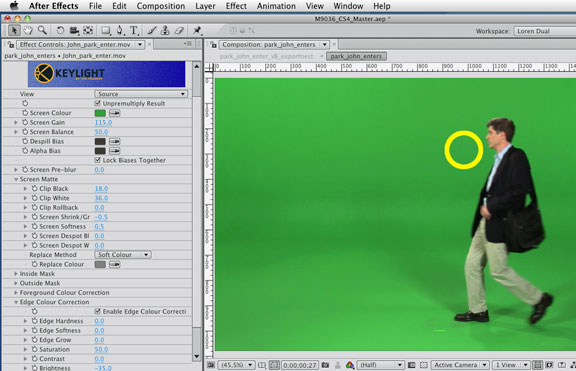

The technique of keying out a background of a consistent color is often called bluescreening or greenscreening, although you don't have to use blue or green you can use any solid color for a background.ĭifference keying defines transparency with respect to a particular baseline background image. Keying makes it easy to replace a background of a consistent color or brightness with another image, which is especially useful when working with objects that are too complex to mask easily. When you key out a value, all pixels that have similar colors or luminance values become transparent. Keying is defining transparency by a particular color value (with a color key or chroma key) or brightness value (with a luminance key) in an image. Then you'll add a title to the promo, and place a station ID into the composition to complete the project.
#After effects keylight 1.2 exclude how to#
You'll learn how to use keying effects to remove the green background and clean up the edge of the key to remove any lingering green spill. You'll begin by working with live-action footage of an actor captured on a greenscreen stage. In this exercise, you'll build a promotional spot for a weekly news segment on a fictional television station.
#After effects keylight 1.2 exclude professional#
I would definitely experiment with it again, possibly next year when I get the chance to make my own film.This article is adapted from Adobe After Effects CS3 Professional Classroom in a Book. It is an interesting subject and a great experience. I enjoyed filming in the green screen room and I wish I had more time to do some more work within special effects. I found creating a video on After Effects quite simple because it was straight forward. I dragged and dropped the background After Effects. Then I had a look on Google images for a background for my green screen and found a space theme background on: Then on Hue and Saturation, I changed the Channel Control to Greens and adjusted the Channel Range to decrease the colour of green to black and white which disguises the green screen even more.

Then I clicked Effects on the top tool bar and selected Colour Correction > Hue and Saturation. I increased the Clip Black which increased the black colour on the video and I reduced the Clip White to make the white areas all white instead of grey because otherwise it would be see through.įurthermore, I increased the Screen Softness to create soft edges around my subject. This effect enables you to see the green screen areas that are still visible which couldn’t be seen on the normal setting. This made the image turn into a threshold effect. Then by selecting the drop down tab next to View, I selected Screen Matte. After increasing the Screen Gain it made it all black apart from the faces. Then I Increased the Screen Gain because the green screen was still slightly visible in areas.


Then the keylight options appear and I changed the Screen colour from black to the colour of the green screen on my video by using the sampling tool beside the colour. Then selected Effects > Keying > Keylight (1.2) Firstly I opened up my green screen video up in After Effects.


 0 kommentar(er)
0 kommentar(er)
